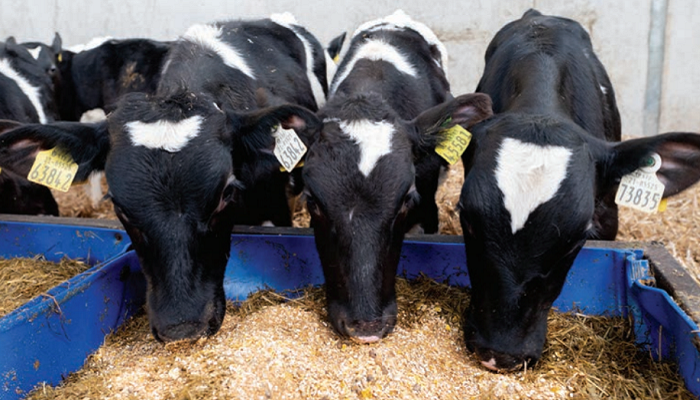11 April 2023
Watch: Avoiding the post-weaning growth check

Weaning can be a particularly stressful time for calves, as they make the transition from a liquid feed diet to a solid feed diet, explains Tommy Cox, Teagasc DairyBeef 500 advisor.
At weaning, calves should be healthy and not stressed. If there are any ‘issues’ with them, continue milk feeding. Stressful events such as castration, disbudding or vaccination will cause upsets and potentially cause a growth check after weaning.
Calves can be either ‘abruptly’ or ‘step’ weaned. Stepped weaning is when the amount of milk being fed and the number of feeds/day are steadily reduced. Generally, stepped or gradual weaning is achieved by reducing the volume of milk fed over seven to 10 days. If calves are being fed milk twice a day, weaning can be achieved by cutting down to once-a-day feeding. Both stepped weaning and abrupt weaning can work well provided the calf’s rumen is adequately developed and that they are eating at least 1kg of calf ration per day.
However, stepped weaning reduces the stress at weaning and helps avoid temporary setbacks in growth rate. The post-weaning growth check found in many calves is due to three factors. The first is the low intake of dry feed up until weaning, resulting in limited rumen development. This results in a growth check for about two weeks, while the rumen becomes accustomed to digesting significant quantities of dry feed.
The high intake of bulky roughage such as grass and hay is also a factor. Calves are physically unable to eat enough roughage to sustain rapid growth weights with their small, developing rumen. In addition, calves may become stressed when feeds are changed. Feeding concentrates before, during and after weaning should limit the level of any growth check. If a growth check does occur, the lost growing time will never be made up and it will take long to attain target weights.
In the below video, Tommy explains the steps to take to ensure weaning is a success.
Farm case study
DairyBeef 500 farmer Gareth Peoples farms full-time in Tullyannon, Carrigans, Co. Donegal. Gareth operates a calf to steer beef system. Eighty calves were reared this year on the farm, a mix of autumn and spring-born Holstein Friesian male calves, all of which will be slaughtered as steers at approximately 24 months of age. The plan is to increase to over 100 in time.
“All calves on the farm are sourced locally,” said Gareth. “This means less stress for young animals, minimising any potential disease outbreak. My preference is for a calf that is at least three weeks of age as, at that stage, immunity has increased and they are less vulnerable.”
Two days after arriving on farm calves get a vaccine for pneumonia and a drench to prevent coccidiosis. Calves are fed 750g of a 23% crude protein milk replacer twice daily from arrival until they are about five weeks. They are then cut back to once-a-day feeding and from then on the quantity of milk replacer fed will be reduced until weaning.
“From five weeks, calves are fed 400g of milk replacer in three litres of water and are kept on that regime until they reach their targeted weaning weight of 90kg at generally 55 to 60 days,” said Gareth.
From arrival, calves are introduced to a highly-palatable coarse ration. The ration contains 19% crude protein and is made up of high-quality ingredients, including: soya bean; barley; flaked maize; soya hulls; distillers; and molasses. It also contains an acid buffer and yeast to prevent digestive upsets.
“In my experience, calves can be slow enough to consume any significant levels of concentrates. But once they start, intake increases rapidly especially when they are reduced to once a day milk feeding.
“Keeping the troughs clean and feed fresh, from the start, is vital to get calves to start consuming reasonable levels. Generally at weaning calves would be consuming over 2kg of concentrates per day and they are kept on this level until turnout.”
Straw is the fibre source and calves have access to clean fresh water at all times. When calves are first let out to grass, they are put out to stronger and stemmy covers. Gareth said this ensures extra fibre and that the grass isn’t too lush, reducing the risk of summer scour.
“We continue the concentrate supplementation for the first few weeks post turnout and once calves get accustomed to the diet concentrates are reduced and the quality of grass that they are grazing is improved,” Gareth concluded.
This article first appeared in the March/April edition of Today’s Farm, while the video was produced as part of the Teagasc DairyBeef 500 Spring Series on Agriland.
For more information on the Teagasc DairyBeef 500 Campaign, click here.
Photo caption: Research recommends a concentrate to roughage ratio by weight of 8:1 or 200g/ head/day of forage to pre-weaned calves. Clive Wasson
